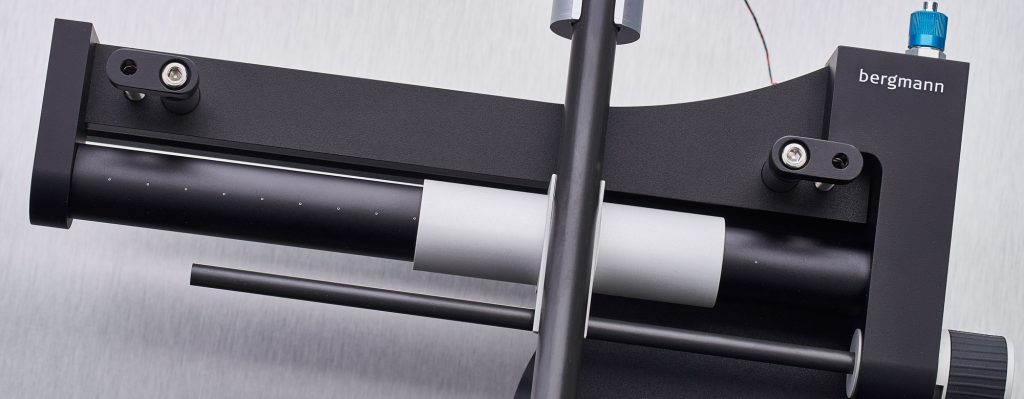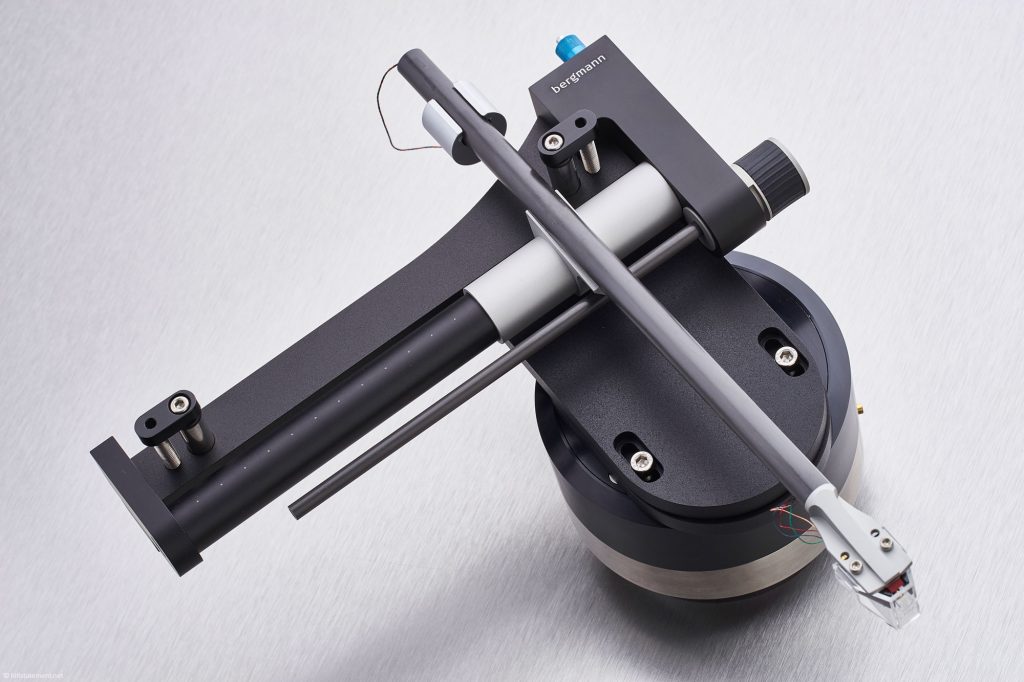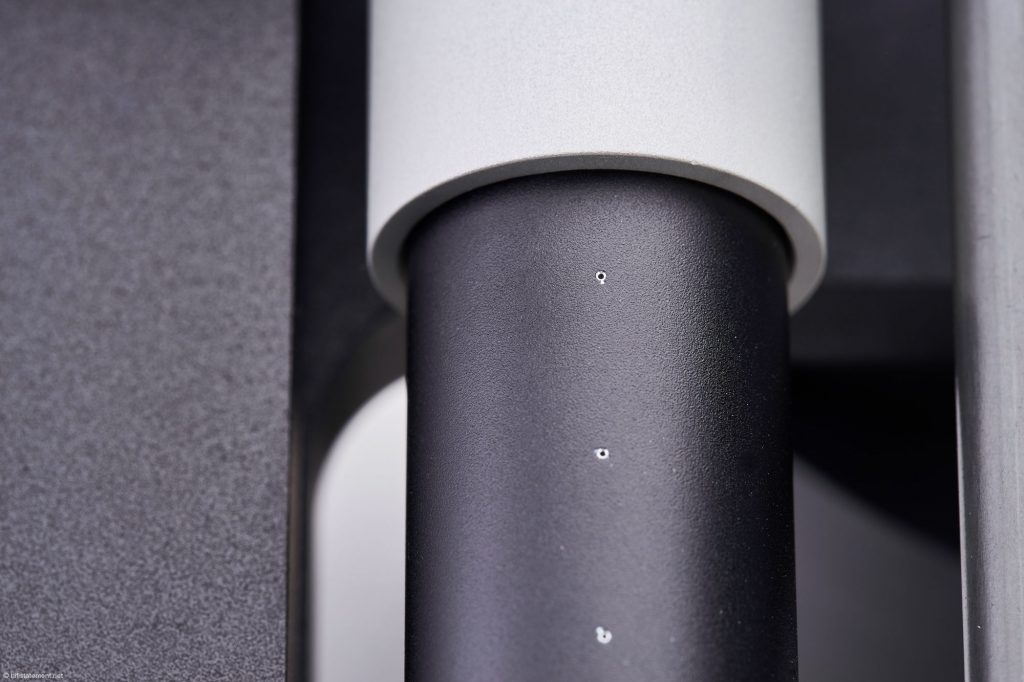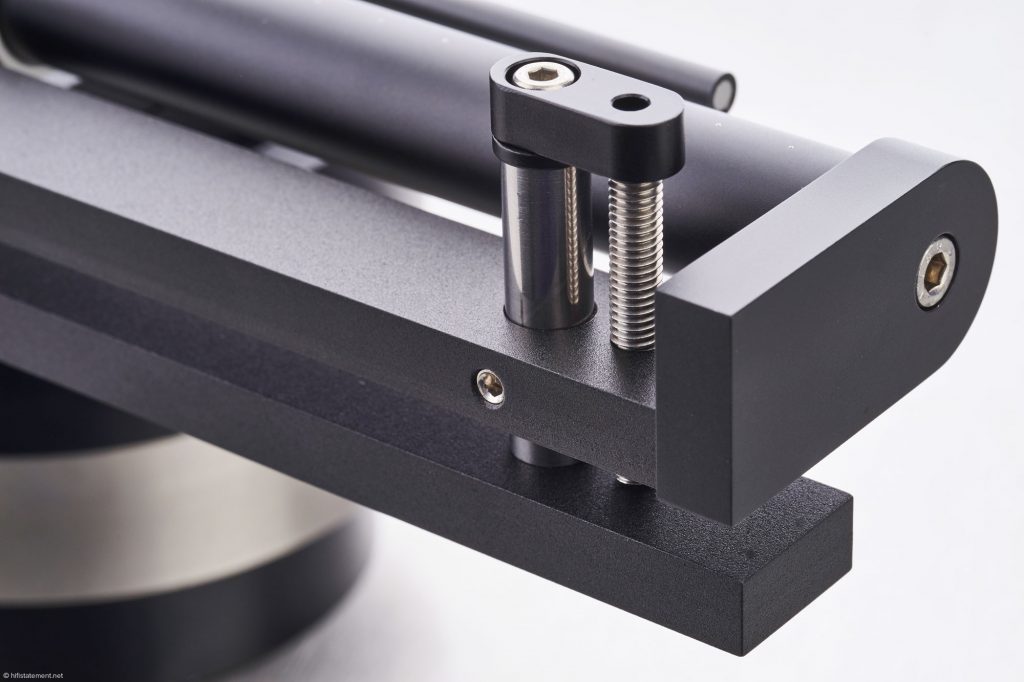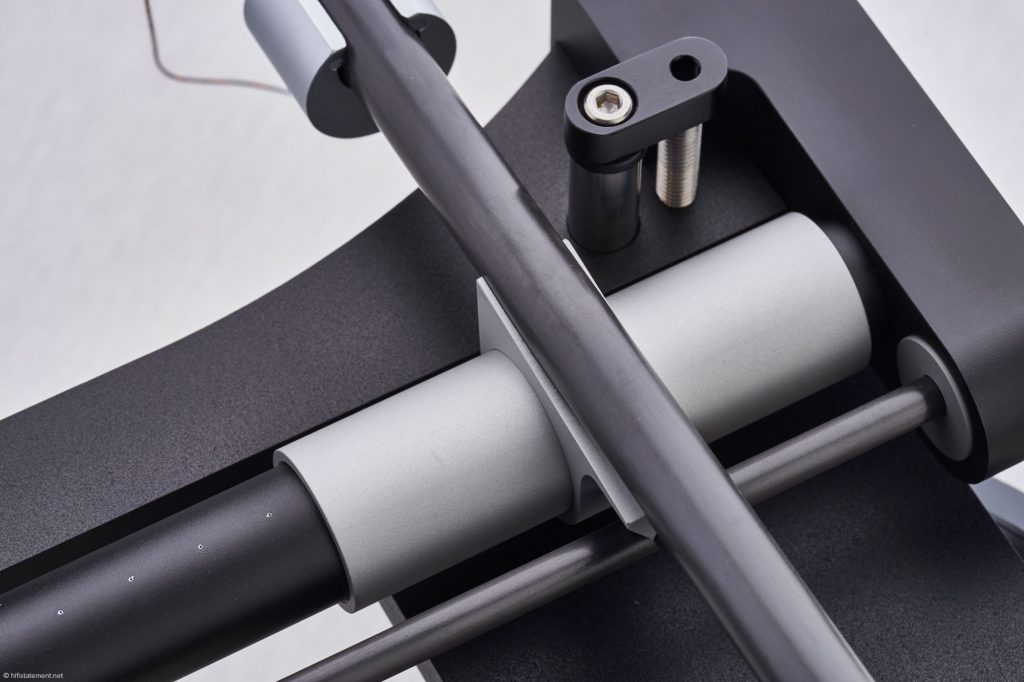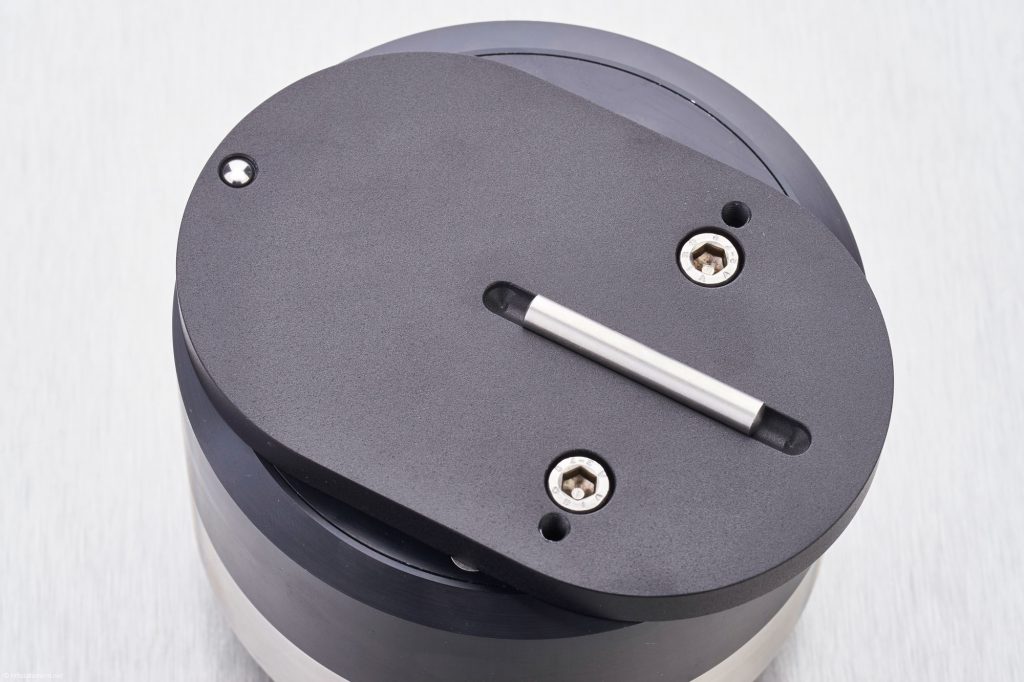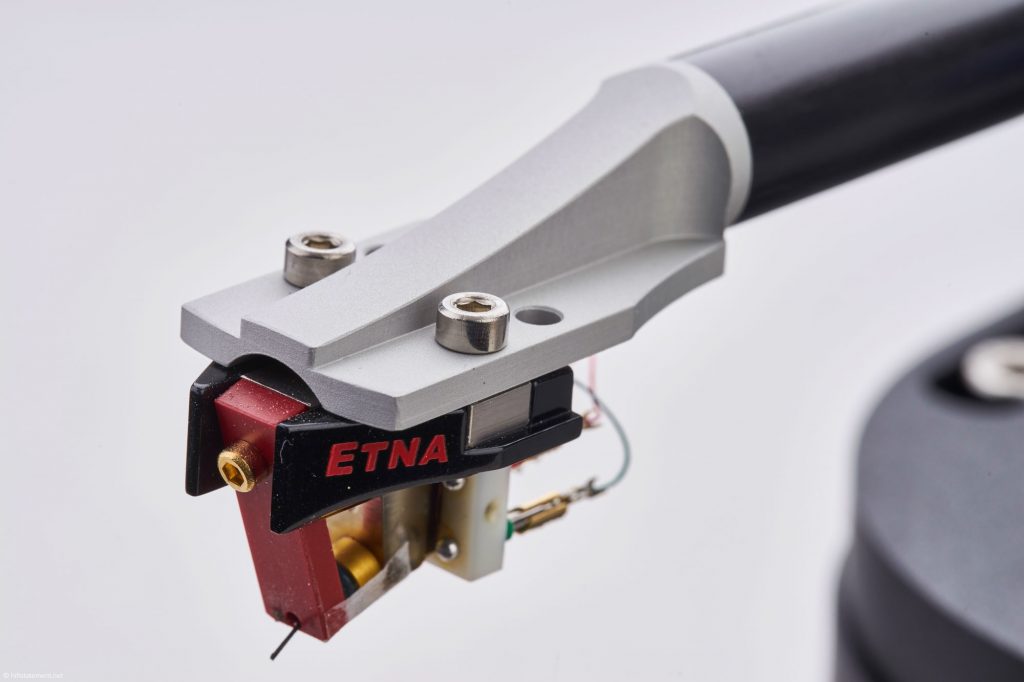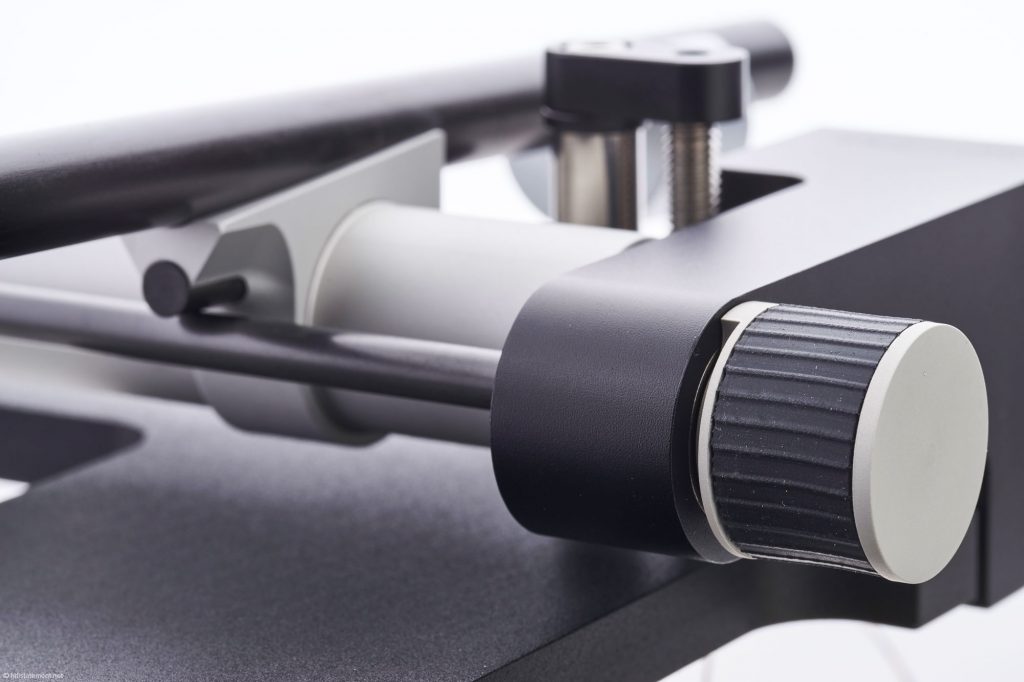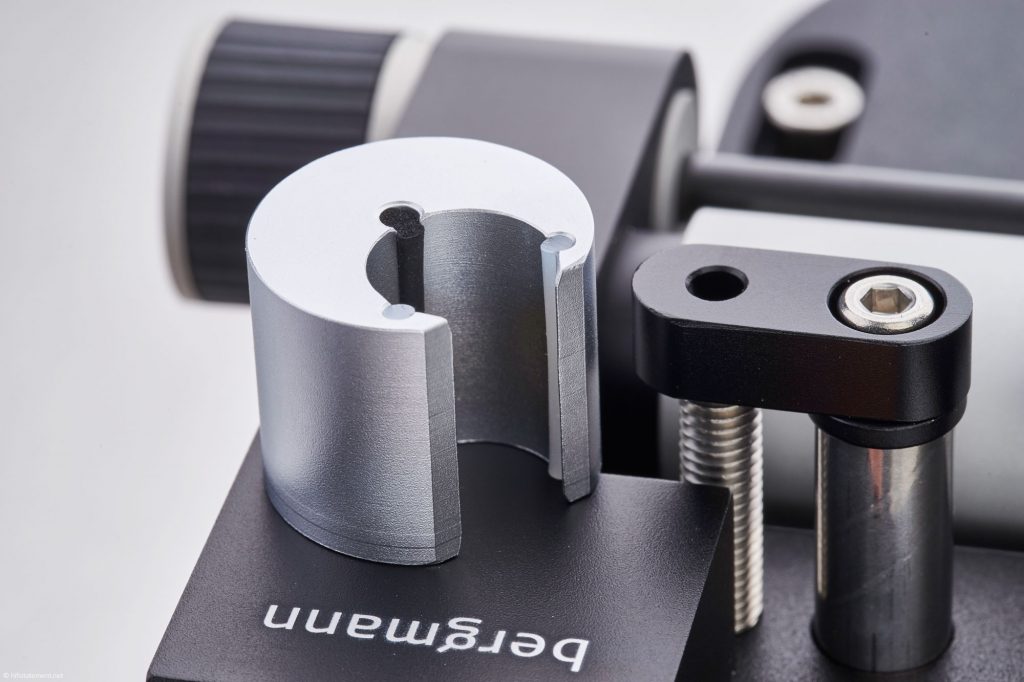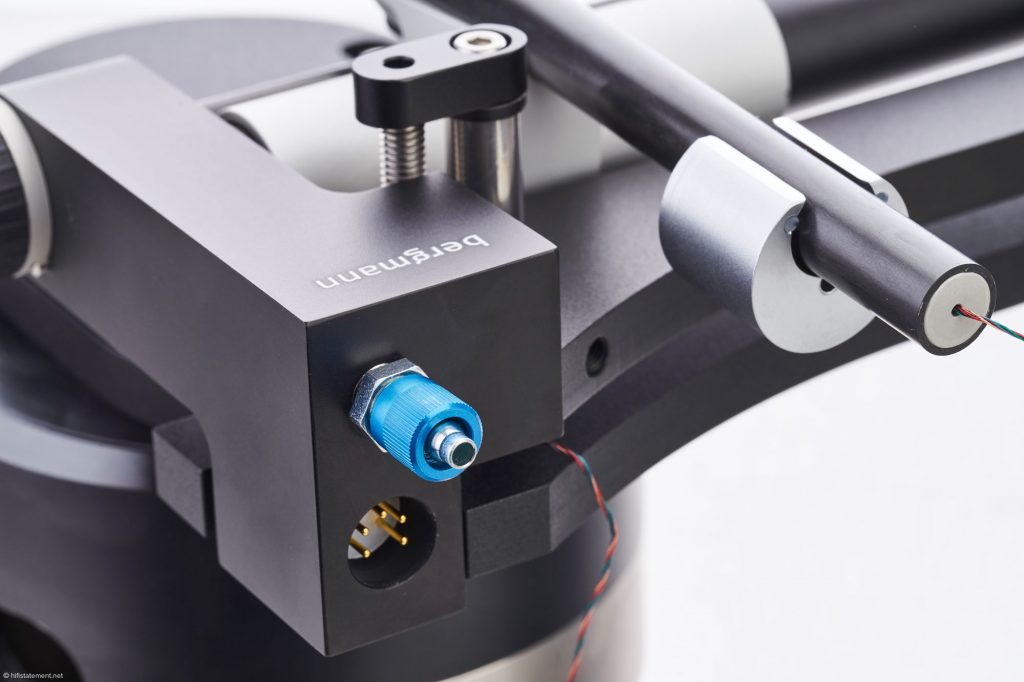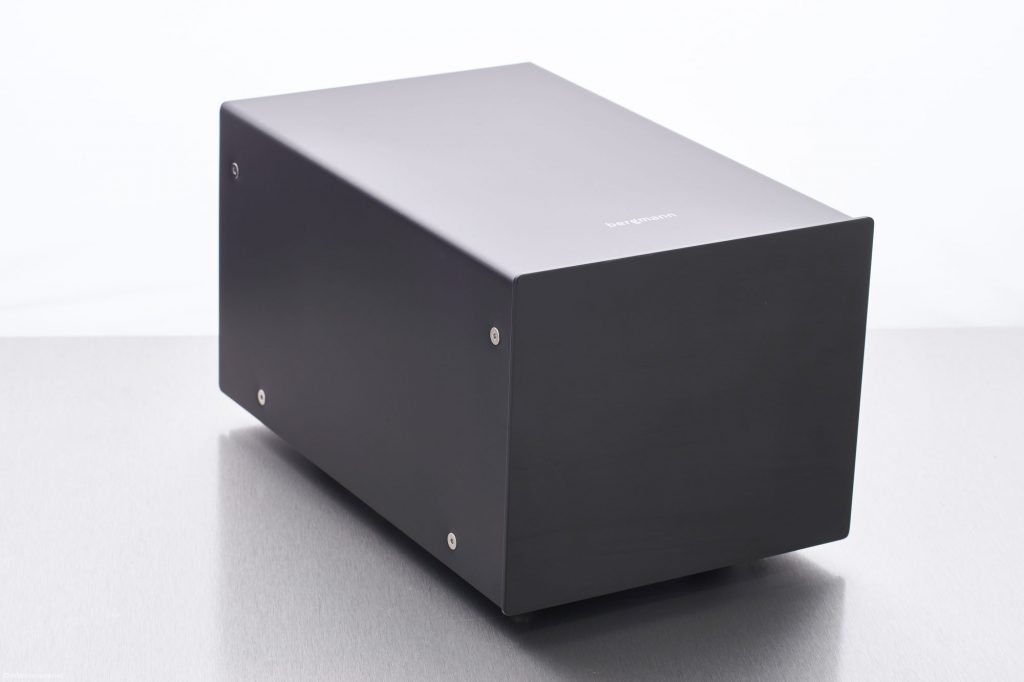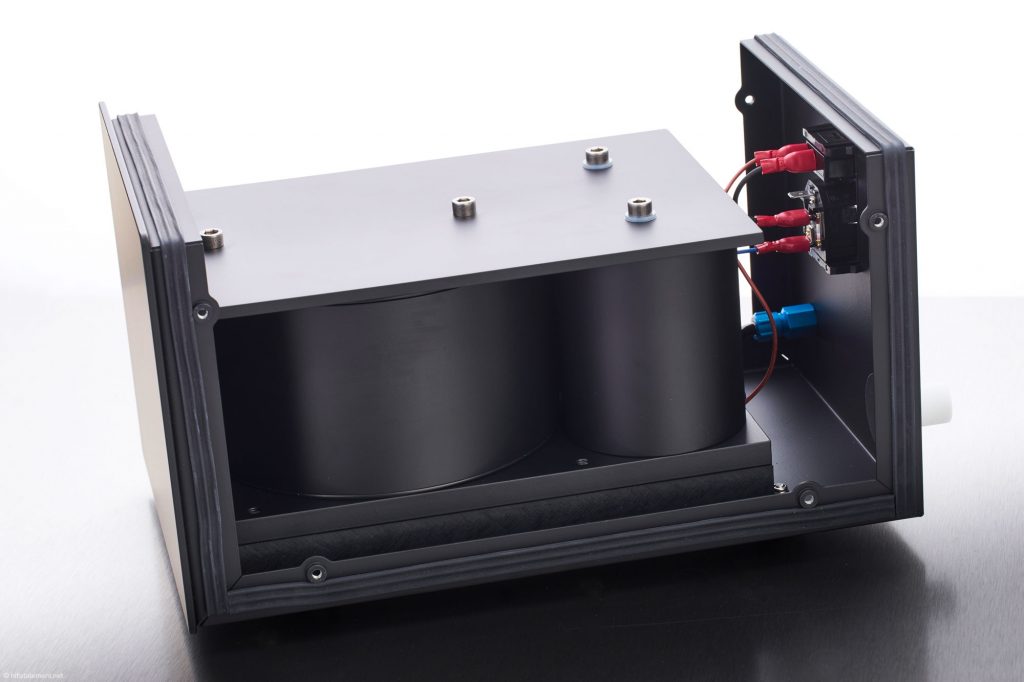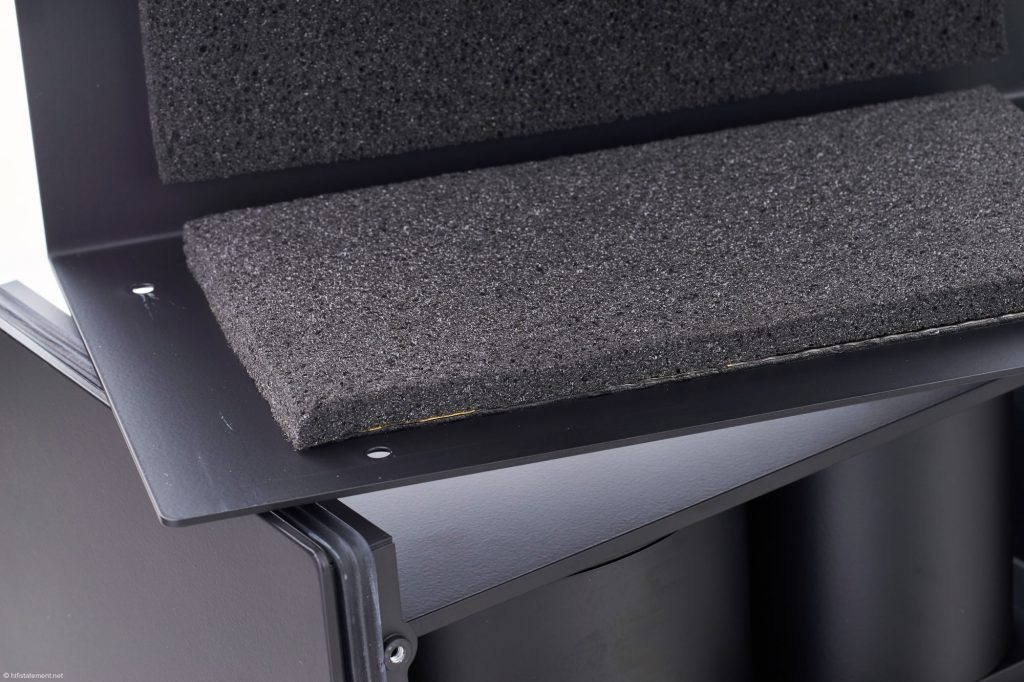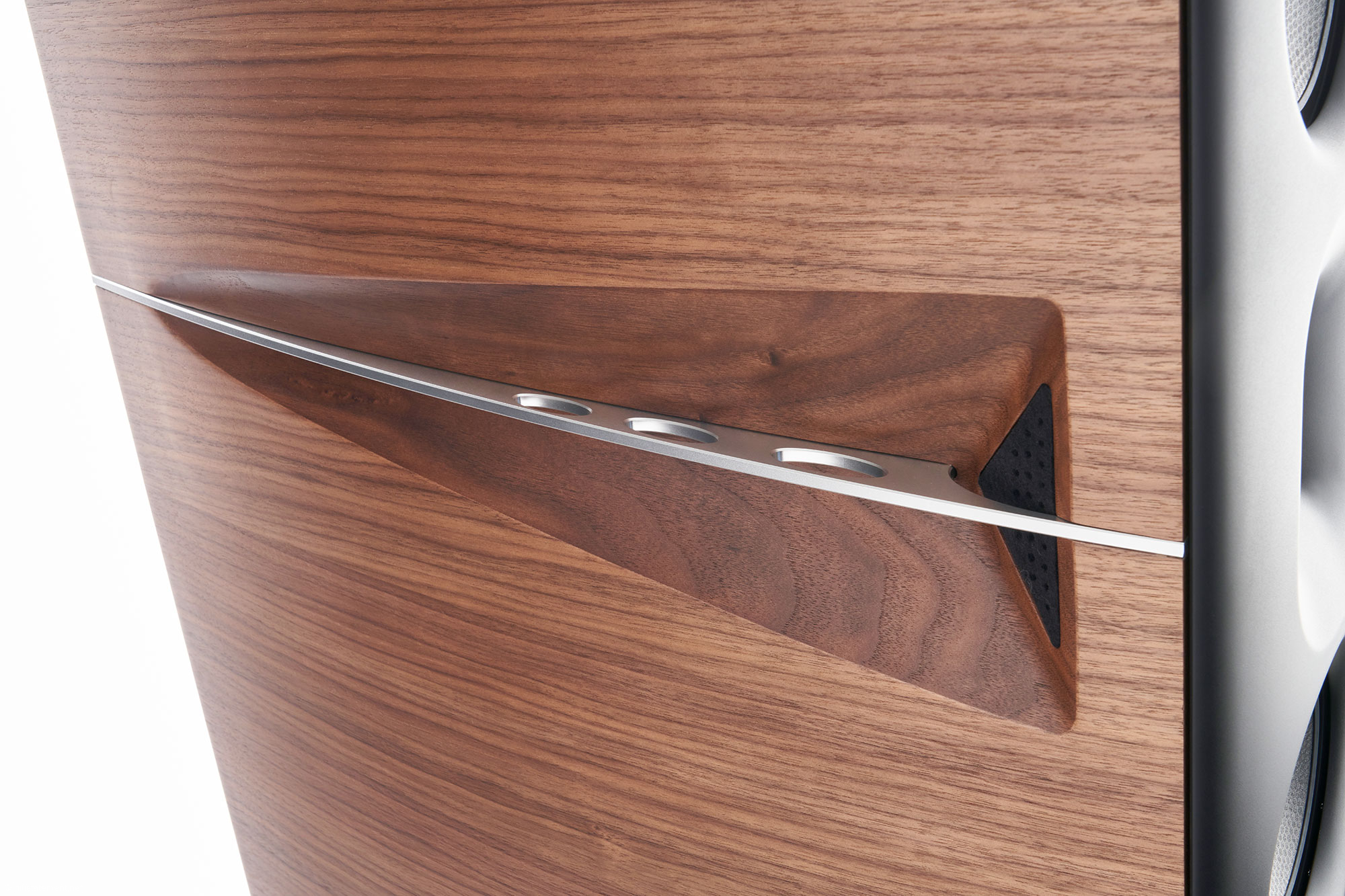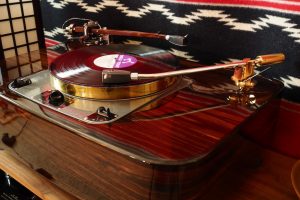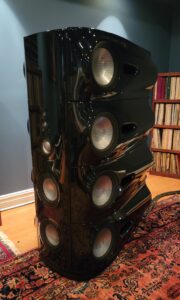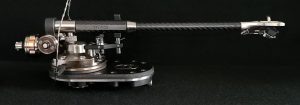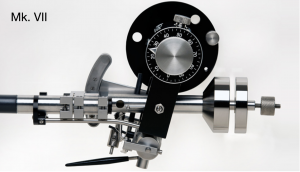The Odin currently marks Bergmann's flagship in their range of air bearing tonearms. Head of company Johnnie Bergmann did not design it specifically for one of his turntables, but as a tonearm that is intended for universal application also on turntables from other manufacturers.
Whilst visiting the company's headquarters in the Danish town of Hobro some time ago, myself, Johnnie Bergmann, Werner Obst (who has been distributing Bergmann's analogue portfolio in Germany almost since its market introduction) had already arranged for a sample of the Odin to be sent to Hifistatement. This was eventually; it did not happen before the High End show in Munich 2018, which incidentally I followed up with a little vacation. But even after having the tonearm in-house, still some time went by before I was able to install the first cartridge on it. In this early version of the Odin, the supplied template, which helps to mark the position of the threads for the two M6 screws, is designed for Bergmann turntables or others with a platter diameter of 300 millimeters. (Meanwhile, Johnnie Bergmann is working on a universal version of it.) But, for the LaGrange I quickly got a modified version of the template. It was not until I tried to use the template for preparing one of my interchangeable tonearm bases for assembly that I noticed that a linear tracking tonearm installed to the 9-inch position would protrude towards the left rear side, and therefore get in the way of a long arm installed to the 12-inch position.
The Odin mounted to a tonearm base of the Brinkmann Lagrange.
However, I did not want to do without a second arm. Finally, two solutions emerged: First, the eccentrically-built base, which had been designed for extra-long tonearms such as the Ortofon 309 and had been modified successfully for the test of Einstein's The Tonearm, could be turned towards the platter so that the Odin could be mounted in the 12-inch position, while a short arm could be operated on the 9-inch position. However, if you want to use a long arm in addition to the Odin—at the moment the combination of Einstein's The Tonearm and Transrotor's Tamino is impressing me a lot—you have to unscrew the boomerang-shaped chassis of the LaGrange from the base plate which incorporates the bearing heater, turn it by 180 degrees and then fix it again. Despite the connections having to be removed and resoldered, I opted for this variant. As a precaution, however, at AMG, located in the region of the Upper Palatinate, I got the necessary threads machined to the two aforementioned bases.
The air pipe with its air outlets.
As I have already mentioned several times within my report on the visit to Johnnie Bergmann and Eva Seiberg, I really find it hard to understand that Bergmann Audio has discontinued the extraordinary Sleipner—for me still one of the best two or three turntables I had ever come across in my listening room. In this context, Bergmann's previous tonearm flagship unfortunately became obsolete. In the future its place shall be solely taken by the new "reference tonearm," as Johnnie B. calls it. In contrast to the Sleipner tonearm, the Odin is intended to be compatible with turntables from other manufacturers as well, and therefore will be available without the counterpart from its own home. Given this, its price will be a good deal higher, since the Odin will not benefit from the pressurized air of the turntable, but must be sold with its own air supply.
The Odin has its air pipe supported also at the “other” end. Left of it, the height adjustment mechanism is to be seen.
As Johnnie B. explained in an email, he focused on further improving the stability and strength of both air bearing and tonearm tubes. Therefore, he decided not to support the air pipe with its air outlet openings, as usual with his designs, on one side only, but on both sides instead. The structure of the tonearm tube got also optimized: He combined two carbon tubes with an intermediate damping layer to achieve higher rigidity and perfect resonance control at the same time. The headshell is now machined from a solid aluminum block and glued to the carbon tube. The connection between the tonearm tube and the sliding pipe that floats on the air cushion happens now to be even more stable than in all previous Bergmann tonearms.
The connection between the sliding pipe floating on the air cushion and the tonearm was designed for maximum resonance reduction.
All of the measures taken, Johnnie B. says, lead to a richer and more dynamic sound when compared to that of the slightly more delicate performing Magne tonearm. In terms of three-dimensional imaging, however, the Odin shouldn't be inferior to the Magne—which we simply do not accept without further proof. Already firmly appointed with Werner Obst for the near future is the test of the Galder turntable, which is able to accept up to four arms and that is planned to then carry both Magne and Odin arms. The Odin is thoroughly wired with strands of very flexible copper, i.e., from the clips of the cartridge connector pins to the DIN connector on the rear side of the arm. The counterweight is decoupled from the arm tube by means of three rubber inserts. The supply hose for the pressurized air allows for setting up the air pump a few meters away from the tonearm; it operates extremely quiet, so that it never becomes annoying.
The level board: The inserted steel rod ensures that the arm mounted on it can only be moved longitudinally. It also serves for the horizontal alignment of the arm.
Once the two threads required for assembly have been positioned on a tonearm board or base at the given distance, the installation of the Odin can be carried out relatively easy. First, the so-called "level board," which is an aluminum plate with holes, threads, and recesses for a steel rod and a steel ball, is bolted to the base. Thereafter, the steel rod is inserted into its recess, and subsequently the tonearm installed and secured with two screws. Thanks to the slots in its base plate, the tonearm can be moved back and forth in a longitudinal direction, safely guided by the steel rod. This later on facilitates the stylus of the cartridge to be adjusted to the linear tracking line using the protractor. Since the steel rod is somewhat thicker in diameter than those of the machined guides in both level board and base plate, the base plate can be minimally tilted around the rod, thus allowing the horizontal alignment of the entire arm. After the cartridge has been mounted to the headshell, the tracking force set, and the height position of the air pipe with its air outlets adjusted, you only have to move the arm on the level board until the tonearm has no overhang anymore. When tightening the screws of the base plate, however, make sure that the arm is exactly horizontal again. However, that sounds more complicated than it really is. The arm is well thought out, so that the installation quickly turns into a joyful endeavour.
After loosening these screws, the tonearm can be moved longitudinally, so that the cartridge tracks the record without any tracking error. They also serve for the horizontal alignment of the arm.
First, I installed the Lyra Etna to the Odin, primarily to burn-in the inner cabling of the tonearm. With the Clearaudio/Souther or even with Kuzma's Airline, now and again the stylus jumped out of the groove, so I didn't start the procedure with any of my audiophile treasures, but rather records that I hadn't listened to for quite a long time and that primarily promised fun, like I Giganti Del Jazz 13 by Milt Buckner. This album, issued by an Italian low-budget label, is musically and sonically speaking a real stroke of luck—unfortunately this cannot be said about most titles of the series. In the magical edition no. 13, Milt Buckner on the Hammond, Buddy Tate on tenor sax, and Wallace Bishop on drums seem to be grooving like hell, occasionally verbally cheered by the organist. Despite its mid-tempo, "When I'm Blue" sparkles with an irresistible rhythm, and the Hammond whimpers, whispers, screams and clatters, while the opulent bass drum definitely would credit one or the other high-end recording. In "You Have Changed," the tenor saxophone with its rich, warm tone flatters the listener—you're made to melt away!
The headshell milled from solid aluminum is connected to the double-walled carbon tube using a two-component adhesive.
And because it pleased me that way, I stayed with Milt Buckner: On Rockin 'Hammond, an album recorded for Capitol in 1956, the organist on some tracks simultaneously plays Hammond and grand piano, while the sound engineer is playing around with some reverberation. In "The Beast" as well as in "One O'Clock Jump," the sound of the grand piano pounces as hard and straight as it would decades later on the infamous recordings of Three Blind Mice, produced by "Tee" Fujii. The music is not necessarily innovative, but swings with power and just puts you in a buoyant mood. The rich golden dazzling of the colours, the stable imaging of the instruments, the openness of the performance, and the widespread absence of technical artifacts in the sonic image, add their contribution in the same way. The fact that the Etna usually gets vehemently down to business and pushes forward in an unequaled manner, is confirmed by the Odin, too. But I don't remember to ever have heard the Lyra performing in such a smooth and warm way as on these two records.
The knob with the eccentrically positioned rod handles the lifting of the tonearm.
Like the Sleipner arm, the Odin also never loses its calm, whether when confronted with accumulations of dust or with records showing an eccentric center hole—except with me: On one track, the image suddenly lost stability, the stylus even jumped back one turn. As mentioned, the reason was me—or, let me put it in a more friendly way: an operational error of mine. I simply didn't lower the lift far enough. By the way, the lift in this design is not operated by a lever, but via a knob, so that the stylus only contacted the groove, instead of fully touching down. After I got used to having the lift sloping down completely, no more cuing incidents occurred.
The counterweight is decoupled by three rubber inserts.
After having completed the three-day burn-in phase, the arm then had to part from the LaGrange to leave the turntable for the photo studio. Since the position for placing the base plate on the turntable is defined by those two threads that take the level board, the remounting of the arm only required a readjust of the stylus position, the tracking force—for the photo the counterweight had been removed—and the horizontal alignment. Given this, I decided to install a new cartridge right away, which happened to be the Lyra Titan i, which I had "rediscovered" when testing the Keces Ephono, and which matched the Sleipner so well about five or more years ago. The Odin quickly revealed the differences between the two Lyras: The Etna is slightly cleaner, more open and a little more agile, while rhythmically more pounding. Focusing on these considerations, it pleasantly surprised me while mounted on the Odin, but it didn't quite catch up with the tonal richness of the Titan i. It's awesome to perceive how clearly the Odin reveals the sonic differences between the two Lyras—and that it unleashes their individual excellence without even acting a part!
The connector for attaching the air pump tube; below, the DIN socket for taking the phono cable.
Not that I get carried away in sonic colourfulness: The respective test records show that also in terms of spatial imaging the Odin leaves nothing to be desired. Here it is at least equivalent to the best pivoted tonearms, although, if my memory serves me right, it cannot fully achieve the fantastic performance of the Sleipner in this discipline. However, I must commit that in this case the Odin —unlike the Sleipner arm back then—is not mounted to an airbearing turntable. Therefore I'm already very much looking forward to Bergmann Audio's Galder turntable.
Fortunately, the air pump appears to be rather unimposing, both visually and acoustically.
Since the Titan i is intended to find its way back into the Breuer arm on the Brinkmann Avance in the living room, and the Odin surely is going to remain in my listening room until the Galder arrives, I could not help myself, but installed another cartridge on the Bergmann arm. In principle, it would do no harm to rely on experiences made with the Lyras only for this review. The Brinkmann EMT ti is slightly heavier than the Lyra, is somewhat taller and has a higher output voltage, so it differs fundamentally from the Titan i—but it still perfectly blends with the Odin.
Not the slightest hint of nervousness was to be detected, which sometimes may arise in poor recordings with a Brinkmann, Breuer, or short AMG arm. However, the Odin doesn't limit the EMT's rhythmic appeal at all. The lows push with a good deal of thrust, while the sonic image seems more stable and a touch tidier than usual.
The solid construction ensures low noise emission.
I would never go so far as to claim that I could be hearing the fluctuating distortions caused by the alternating tracking angle errors along the stylus' curved path over the record's surface. Oh no. I still believe that it makes no sense to establish a relationship between the design features of a component and its sonic behaviour. But the Odin does a lot right by adding almost no technically associated artifacts to the music. The linear tracking, the fairly long tonearm, the considerably high effective mass of 14 grams, and the care with which Johnnie Bergmann pays closest attention to a strict resonance control in his designs, all of these characteristic attributes certainly help it a lot.
The inner design of the air pump reveals further sound-insulating measures.
Statement
Sonically, the Odin restrains its impact to the music to an absolute minimum, as it does not add any colouration to the tracked music signal, and clearly points out the individual characteristics of every cartridge installed to it. It displays such a sovereignty that it instantly evokes reminiscences of the heavy analogue classics from Japan. Bergmann's "reference tonearm" presents itself in superb craftsmanship, and offers a problem-free set up to any reasonably experienced analogue aficionado, including when installing the second cartridge to it. (But see my comments above about the steps that you may have to take with second tonearms.)
With the Odin, Johnnie B. has created a universally-applicable linear-tracking tonearm, one that takes the centre stage without any affectations, strongly recommending itself for an everyday use. Despite its appearance of being thoroughly functional, sonically the Odin is of a high-caliber!
Contact Bergmann Audio or one of its distributors for current pricing.
Specifications
- Tonearm Principle: Linear tracking airbearing tonearm
- Armtube: Aluminum/Carbon with inner damping
- Counterweight: Decoupled from tonearm
- Adjustments: Vertical tracking Angle (VTA), overhang, azimuth, tracking force
- Wiring: High-quality copper strands
- Clips; Gold-plated copper
- Connector: DIN
- Effective mass: 14 g
- Weight: 1,180 g incl. armboard
- Armboard; Aluminum
- Dimensions (H/W/D): 70/265/290 mm
- Air supply: Very silent, clean, dry and uniform airflow, exchangeable dust filter
- Dimensions (H/W/D): 135/155/330 mm, 5,7 kg
Bergmann Audio Odin
Price: 8,000 euros
DISTRIBUTOR
WOD-Audio - Werner Obst Datentechnik
Westendstr. 1a
61130 Nidderau
Germany
+49 6187 900077
All photographs courtesy of Dirk Sommer and HiFiStatement




